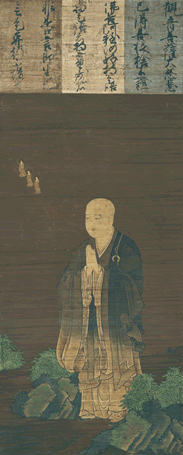Shandao
Shandao | |
|---|---|
善導 | |
 Shandao, Muromachi period, Ōtani University Museum. | |
| Personal | |
| Born | 613 Zibo, Shandong, China |
| Died | 681 (aged 67–68) Chang'an, Shaanxi, China |
| Religion | Buddhism |
| Nationality | Chinese |
| School | Pure Land Buddhism |
| Lineage | 2nd generation |
| Notable work(s) | Commentaries on the Amitāyurdhyāna Sūtra |
| Dharma names | Shandao |
| Temple | Wuzhen Temple Xuanzhong Temple Wenguo Temple Fengxian Temple |
| Senior posting | |
| Teacher | Mingsheng (明勝) Daochuo |
show
Students | |
| Part of a series on |
| Buddhism |
|---|
 |
|
Shandao (simplified Chinese: 善导大师; traditional Chinese: 善導大師; pinyin: shàndǎo dàshī; Japanese: Zendō; 613-681) was an influential writer for the Pure Land Buddhism, prominent in China, Korea, Vietnam and Japan. His writings had a strong influence on later Pure Land masters including Hōnen and Shinran in Japan.
The Samguk yusa records him among the 3 monks who first brought Buddhist teaching, or Dharma, to Korea: Malananta (late 4th century) Indian Buddhist monk who brought Buddhism to Baekje in the southern Korean peninsula, Shandao (also spelled Sundo) monk who brought Buddhism to Goguryeo in northern Korea and Ado monk who brought Buddhism to Silla in central Korea.[1] Buddhism, a religion originating in what is now India, was transmitted to Korea via China in the late 4th century.[2]
In Jōdo Shinshū, he is considered the Fifth Patriarch.
Biography[]
Shandao was born in what is now present Zhucheng. When he was young, he entered the priesthood and devoted himself to the study of the Infinite Life and Vimalakirti Sutras. One day, in the year 641, he visited the temple of the famous Pure Land master Daochao, who happened to be giving a lecture on the Amitāyurdhyāna Sūtra. This lecture ultimately inspired him to follow and then spread Pure Land Buddhism.[3]
Shandao dwelt at Xiangji Temple (Chinese: 香积寺; pinyin: xiāngjī sì) in Shaanxi, which continues to honor his memory and contributions. In his lifetime, Shandao wrote five major works on Pure Land Buddhism, with his commentaries on the Amitāyurdhyāna Sūtra being among the most influential.
Teachings[]
Shandao was one of the first to propose that salvation through Amitābha could be achieved simply through his name. The practice known as the nianfo as a way of singular devotion to Amitābha Buddha was all that was needed. In one of his more famous writings, Shandao spoke at great length about how simply saying the name of Amitābha was sufficient for salvation. Centuries later, Shandao's writings would have a strong impact on Hōnen and the Pure Land Buddhist movement in Japan, particularly the Commentaries on the Amitāyurdhyāna Sūtra (Chinese: 觀經四帖疏), particularly this statement: "Only repeat the name of Amitabha with all your heart. Whether walking or standing, sitting or lying, never cease the practice of it even for a moment. This is the very work which unfailingly issues in salvation, for it is in accordance with the Original Vow of that Buddha."[4]
Prior to this, Amitābha was incorporated into wider practices such as those found in the Tiantai school as part of complex and often difficult practices. Shandao often used imagery such as the "Light and Name of Amitābha" which "embraces" all beings. Ultimately, such writings marked a change in the way Buddhists viewed salvation through Amitābha.
The Three Minds and Four Modes of Practice[]
Among Shandao's teachings are the Three Minds and Four Modes of Practice for Pure Land Buddhism. In the Commentaries, sincere devotion to Amitābha over the long-term leads to three minds, or states of mind:
- The Utterly Sincere Mind
- The Profound, or Deeply Believing, Mind
- The Mind which dedicates one's merit (or good works) toward rebirth in the Pure Land.
In Hymns in Praise of Birth (Wang-sheng-li-tsan), Shandao taught the Four Modes of Practice that develop through devotion to Amitābha:
- Reverence shown to Amitābha and bodhisattvas in Sukhavati: Avalokiteśvara and Mahasthamaprapta.
- Wholehearted and exclusive practice of reciting Amitābha's name.
- Uninterrupted, as in routine, practice.
- Long-term practice.
See also[]
- Buddhism in China
- Buddhism in Korea
- Buddhism in Japan
- Hinduism in Korea
- Indians in Korea
- Koreans in India
- Memorial of Heo Hwang-ok, Ayodhya
- India–South Korea relations
- India – North Korea relations
References[]
- ^ "Malananta bring Buddhism to Baekje" in Samguk Yusa III, Ha & Mintz translation, pp. 178-179.
- ^ Arts of Korea | Explore & Learn | The Metropolitan Museum of Art
- ^ "About Pure Land Buddhism". Archived from the original on August 2, 2013. Retrieved 2008-12-11.
- ^ Coates and Ishizuka (1949). Honen the Buddhist Saint, vol. II. Kyoto : Society for the Pub. of Sacred Books of the World. p. 184.
Bibliography[]
- Inagaki, Hisao, trans. (1999). Shan-tao's Exposition of the Method of Contemplation on Amida Buddha, part 1, Pacific World, Third Series, Number 1, 77-89.
- Inagaki, Hisao, trans. (2000). Shan-tao's Exposition of the Method of Contemplation on Amida Buddha, part 2, Pacific World, Third Series, Number 2, 207-228.
- Inagaki, Hisao, trans. (2001). Shan-tao's Exposition of the Method of Contemplation on Amida Buddha, part 3, Pacific World, Third Series, Number 3, 277-288.
- Pas, Julian F. (1995). Visions of Sukhavati: Shan-Tao's Commentary on the Kuan Wu-liang- Shou-Fo Ching. Albany, State University of New York Press, ISBN 0-7914-2520-7
- Johnson, Peter, trans. (2020). The Land of Pure Bliss, On the Nature of Faith & Practice in Greater Vehicle (Mahāyāna) Buddhism, Including a Full Translation of Shàndǎo’s Commentary Explaining The Scripture About Meditation on the Buddha ‘Of Infinite Life’ (Amitāyur Buddha Dhyāna Sūtra, 觀無量壽佛經) [1], An Lac Publications ISBN 978-1-7923-4208-0
External links[]
- Inagaki, Hisao: Biography of Shan-Tao A comprehensive look at Shan-Tao's life
- Tang dynasty Buddhist monks
- Pure Land Buddhists
- 613 births
- 681 deaths
- People from Zibo
- Jōdo Shin patriarchs